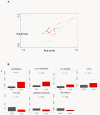Unbalance of intestinal microbiota in atopic children
- PMID: 22672413
- PMCID: PMC3404014
- DOI: 10.1186/1471-2180-12-95
Unbalance of intestinal microbiota in atopic children
Abstract
Background: Playing a strategic role in the host immune function, the intestinal microbiota has been recently hypothesized to be involved in the etiology of atopy. In order to investigate the gastrointestinal microbial ecology of atopic disease, here we performed a pilot comparative molecular analysis of the faecal microbiota in atopic children and healthy controls.
Results: Nineteen atopic children and 12 healthy controls aged 4-14 years were enrolled. Stools were collected and the faecal microbiota was characterized by means of the already developed phylogenetic microarray platform, HTF-Microbi.Array, and quantitative PCR. The intestinal microbiota of atopic children showed a significant depletion in members of the Clostridium cluster IV, Faecalibacterium prausnitzii, Akkermansia muciniphila and a corresponding increase of the relative abundance of Enterobacteriaceae.
Conclusion: Depleted in key immunomodulatory symbionts, the atopy-associated microbiota can represent an inflammogenic microbial consortium which can contribute to the severity of the disease. Our data open the way to the therapeutic manipulation of the intestinal microbiota in the treatment of atopy by means of pharmaceutical probiotics.
Figures



Similar articles
-
Differences in Gut Microbiota Between Atopic and Healthy Children.Curr Microbiol. 2015 Aug;71(2):177-83. doi: 10.1007/s00284-015-0815-9. Epub 2015 Apr 14. Curr Microbiol. 2015. PMID: 25869237
-
A novel combined approach based on HTF-Microbi.Array and qPCR for a reliable characterization of the Bifidobacterium-dominated gut microbiota of breast-fed infants.FEMS Microbiol Lett. 2013 Jun;343(2):121-6. doi: 10.1111/1574-6968.12138. Epub 2013 Apr 15. FEMS Microbiol Lett. 2013. PMID: 23521087
-
High taxonomic level fingerprint of the human intestinal microbiota by ligase detection reaction--universal array approach.BMC Microbiol. 2010 Apr 19;10:116. doi: 10.1186/1471-2180-10-116. BMC Microbiol. 2010. PMID: 20398430 Free PMC article.
-
Intestinal microbiota: a source of novel biomarkers in inflammatory bowel diseases?Best Pract Res Clin Gastroenterol. 2013 Feb;27(1):47-58. doi: 10.1016/j.bpg.2013.03.005. Best Pract Res Clin Gastroenterol. 2013. PMID: 23768552 Review.
-
Probiotics in the development and treatment of allergic disease.Gastroenterol Clin North Am. 2012 Dec;41(4):747-62. doi: 10.1016/j.gtc.2012.08.007. Gastroenterol Clin North Am. 2012. PMID: 23101685 Review.
Cited by
-
Altered Gut Microbiota Diversity and Composition in Chronic Urticaria.Dis Markers. 2019 Nov 11;2019:6417471. doi: 10.1155/2019/6417471. eCollection 2019. Dis Markers. 2019. PMID: 31827639 Free PMC article.
-
Ratio of Klebsiella/Bifidobacterium in early life correlates with later development of paediatric allergy.Benef Microbes. 2017 Oct 13;8(5):681-695. doi: 10.3920/BM2017.0020. Epub 2017 Oct 12. Benef Microbes. 2017. PMID: 29022383 Free PMC article.
-
A compromised developmental trajectory of the infant gut microbiome and metabolome in atopic eczema.Gut Microbes. 2020 Nov 9;12(1):1-22. doi: 10.1080/19490976.2020.1801964. Gut Microbes. 2020. PMID: 33023370 Free PMC article.
-
Akkermansia muciniphila Exerts Lipid-Lowering and Immunomodulatory Effects without Affecting Neointima Formation in Hyperlipidemic APOE*3-Leiden.CETP Mice.Mol Nutr Food Res. 2020 Aug;64(15):e1900732. doi: 10.1002/mnfr.201900732. Epub 2019 Aug 16. Mol Nutr Food Res. 2020. PMID: 31389129 Free PMC article.
-
Dietary Geraniol by Oral or Enema Administration Strongly Reduces Dysbiosis and Systemic Inflammation in Dextran Sulfate Sodium-Treated Mice.Front Pharmacol. 2016 Mar 3;7:38. doi: 10.3389/fphar.2016.00038. eCollection 2016. Front Pharmacol. 2016. PMID: 26973525 Free PMC article.
References
-
- Romagnani S. Regulatory T cells: which role in the pathogenesis and treatment of allergic disorders? Allergy. 2006;61:3–14. - PubMed
Publication types
MeSH terms
LinkOut - more resources
Full Text Sources
Other Literature Sources
Medical

